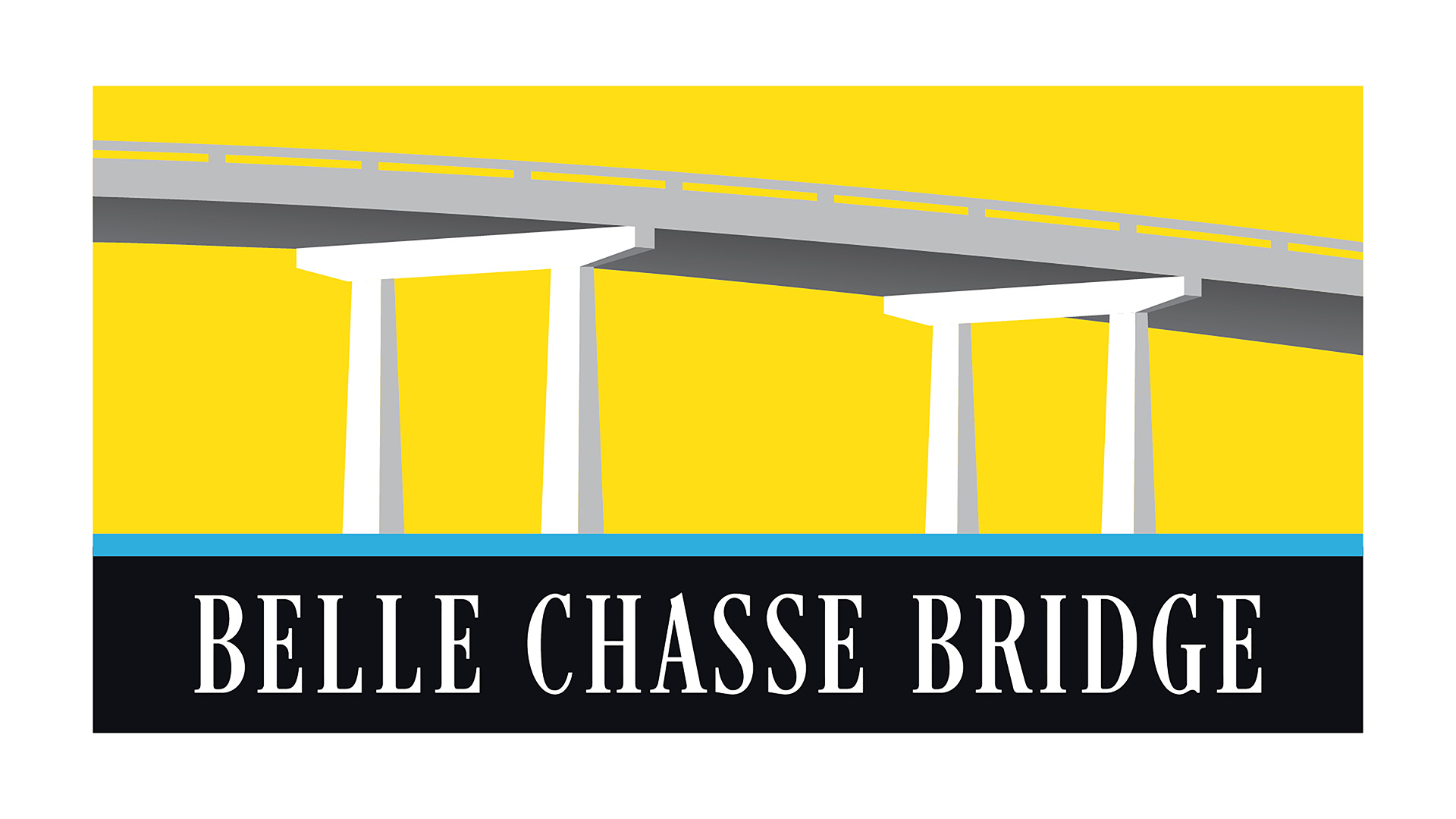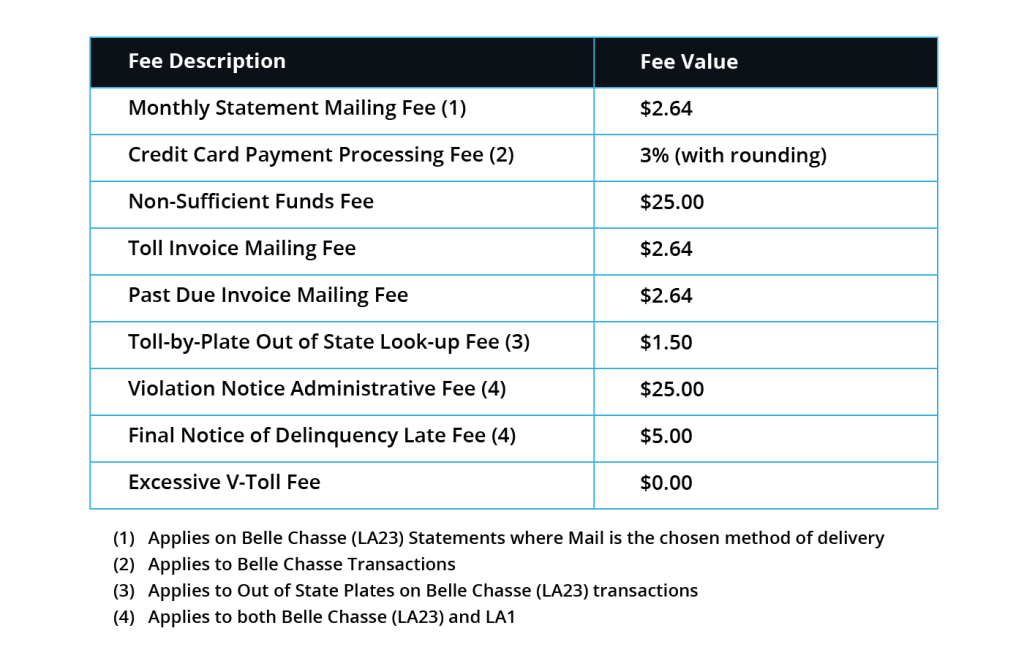- Why was this project needed?
- How will this project benefit the community?
- Where can I find more information about the project?
- When will construction begin?
- Will access and traffic be impacted during construction?
- Will properties have to be purchased from businesses and homeowners to build the new bridge, for the needed right of way (ROW)?
- When will the tolling start, and what will be tolled?
- When the new bridge opens, what will the cost of the toll be for each type of vehicle?
- Will anyone be exempt from paying tolls?
- Do I have to stop to pay my toll?
- How do I get a transponder for my vehicle?
- Are there any additional GeauxPass account fees?
- Will there be a discount for individuals who travel across the bridge multiple times a day?
- Will tolls be charged if there is a hurricane or evacuation?
- If there is an increase in the gas tax, will any portion of those funds be used to reduce the tolls and/or its term?
- Will maritime vessels pay a toll?
- What makes up the toll rate we are paying?
- What will the toll rates be over the 30-year term?
- Is the DOTD making any financial contribution to the Project?
- Why did the DOTD select a public-private partnership (P3) project delivery method?
- Who will own the new Belle Chasse Bridge?
- What benefits does the State of Louisiana gain when Plenary Infrastructure takes over operations of the Belle Chasse Bridge & Tunnel in Spring of 2020?
- Isn’t the private sector only involved in these P3 projects to make a profit?
- Are P3s more expensive than traditionally procured projects?
The need identified in the environmental stages for the project includes improving access and efficiency on the corridor:
Traffic stoppage on Belle Chasse Highway as a result of 10 regular daily vessel openings at 7 minutes each – The Judge Perez Bridge has a closed height of 40 feet above mean high water This requires that the Judge Perez Bridge must open frequently to accommodate marine vessels on the Intracoastal Waterway.
Eliminate unscheduled maintenance & repair closures for both bridge & tunnel – Both the Belle Chasse Tunnel and Judge Perez Bridge are over 50 years old. They must close occasionally for maintenance and the tunnel closes very frequently for cleaning. During these operations, DOTD must use traffic controls which create congestion and delay on Belle Chasse Highway.
Improve vehicular & vessel hurricane evacuation efficiency & reliability – The Judge Perez Bridge must open frequently to accommodate the movement of vessels seeking safe harbor during hurricane and tropical storm events. The randomness of this pattern creates a more congested traffic pattern along Belle Chasse Highway.
Improve daily traffic operations – Improvements made as a part of this project should address future traffic demands on Belle Chasse Highway at the Intracoastal Waterway, forecast to grow slightly from current volumes (estimated at 34,633 vehicles per day) by the Regional Planning Commission’s Travel Demand Model.
The new Belle Chasse Bridge is intended to:
- Improve access to Plaquemines Parish for daily & evacuation traffic with a reliable & efficient GIWW crossing. The project will improve access for residents and businesses by reducing or eliminating scheduled and unscheduled delays associated with bridge operation and bridge and tunnel maintenance.
- Improve GIWW navigation by reducing marine vessel delay. The project will raise the elevation of the bridge. This improves navigation on the Intracoastal Waterway by reducing delay created by the current movable bridge.
- Support opportunities for industrial growth. The project will improve traffic operations on Belle Chasse Highway thus helping meet the needs of the residents and industry in the Parish
- Comply with fiscal constraint objectives. The project will be affordable and consistent with the Metropolitan Transportation Plan objectives and funding capabilities.
- Improve efficiency with lower Operations and Maintenance (O&M) costs. The project will allow for a more efficient allocation of maintenance resources by DOTD.
An overall schedule for the replacement bridge includes survey, engineering and design work in 2020, construction began in 2021, and the new bridge is scheduled to be completed and opened to traffic in 2025. Demolition of the existing bridge and tunnel is projected to be complete by Spring 2026.
Four lanes (two in each direction) will continue to be available for the crossing during the entire construction period (except for limited short-term scheduled reductions of a few hours at a time).
Originally, a number of properties were anticipated to be required for the new bridge to be built. However, the Plenary team and DOTD have worked together to redesign the effort to provide maximum functionality with lessened impacts. Property owners will be contacted directly this year to discuss potential impacts.
Tolling will occur on the new Belle Chasse Bridge. Per the contract, this is only allowed to start upon completion of construction of the new bridge, when it is fully opened to traffic in both directions. This is expected to occur in 2025.
Local auto rates differ by type of vehicle and whether a driver has a transponder. The toll will be $0.25 per automobile for Plaquemines Parish residents with transponders when the bridge opens in 2025. (Transponders will be provided at no cost.)
Click here for information on tolling rates.
Per Louisiana statute, the following users will be exempt from paying tolls [while they are on duty], if they have a transponder:
Publicly owned vehicles, public mass transportation vehicles, parade or group transportation of the Boy Scouts of America, Girl Scouts of America, and Camp Fire Girls (minimum group size of 15), firemen (including volunteer), State police, all law enforcement personnel, state militia, and private vehicles of disabled American veterans.
No, all vehicles will drive through the toll structure at the regular speed limit. Vehicles with transponders will be picked up by the Automatic Vehicle Identification (AVI) system and the cameras will take pictures of the license plates for all other vehicles to coordinate payments. This system is designed to minimize any impact to traffic. All transactions will occur electronically.
As the bridge opening date nears, transponders will be available at no cost to all users. The transponders will be able to be ordered online or picked up locally. The initial transponder will be provided free of charge to each registered vehicle. There is a nominal fee for a replacement.
It is free to open a GeauxPass account. For each crossing prefunded with a credit card, a 3% processing fee will be charged. GeauxPass accounts funded by check, e-check, money order, or payments via the PayNearMe retail network do not incur card processing fees. PayNearMe participating retailers include Ace Cash Express, CVS, Dollar General Family Dollar, Walgreens and Walmart.
During hurricanes the bridge will remain open as long as it is safe for travel, and the Secretary of Transportation has the authority to suspend tolls.
If the gas tax is increased, its revenue will be allocated by the Louisiana State Legislature. The P3 contract allows for the State to make future contributions to reduce the toll rate or shorten the toll term.
Bridge operations and maintenance, toll collection and operations costs, and repayment of the capital incurred to construct the bridge and demolish the prior structures are included in the toll.
Toll rates over the term vary by the classification of vehicle and whether the user has a transponder account or not. A discounted rate is also offered to residents of Plaquemine Parish. Tolls will rise annually at least one penny, totaling 6 cents per each 5-year period. Toll rates will also continue to increase by that year’s Consumer Price Index (CPI) for all rates other than Local Auto.
The DOTD secured and is contributing $103.9 million towards the construction cost of the Project from the following sources:
$45M
USDOT Infrastructure for Rebuilding America (INFRA) Grant
$34.4M
Federal/state funds allocated to DOTD
$12M
Regional Planning Commission
$12.5M
GARVEE Bonds
In addition, the DOTD will contribute $875,000 annually during the operating term, which eliminates indexation on the tolls charged to local users with a transponder.
The DOTD elected to allocate these funds to the Belle Chasse project rather than allocate them to other infrastructure needs in the State.
The P3 delivery method allows the funding to be in place to begin and construct the project much more quickly. The developer secures the remainder of the initial project funding, which is unavailable to DOTD at this time. Additionally, it provides a better value to the State by transferring more project risks to the private partner and creating incentives for the private partner to innovate and deliver more economical construction and long-term maintenance strategies.
- The developer is at risk for on-time and on-budget delivery of the new bridge
- The project budget includes third-party debt along with $30 million of equity directly invested from the developer, committed for the full term of the project.
- Bridge condition guaranteed for the full term of agreement
- Performance and maintenance standards are put in place during operating term, and the developer can have its contract terminated and lose its investment for not complying
- State of Louisiana always owns the bridge and shares in any revenue. The developer absorbs all loss of revenue.
- Alignment of interests between DOTD, the public and Plenary
- Long term repayment of private capital ensures commitment to long-term performance of asset for full repayment of at-risk capital
- Effectively a guaranteed 30-year warranty
- The P3 structure incentivizes a long-term mindset during design and construction, leading to higher quality and lower overall costs than a traditional procurement
The State of Louisiana will retain ownership of the new Belle Chasse Bridge and will exercise control over performance through penalties and hold-backs if the private partner does not meet its obligations under the agreement.
The State of Louisiana will no longer have to bear the costs of operations and maintenance on the existing bridge and tunnel in Belle Chasse once the Plenary team takes these functions on.
The private sector designs and builds both traditional and P3 infrastructure projects. Profit is made in both models; however, P3s are structured so that profitability – and financial loss – are tied to performance. For example, the private partner can be penalized financially if the project is not completed on time or on budget or fails to achieve ongoing quality and condition requirements.
A well-structured P3 delivers better value for the public dollar and saves money because the private sector partners are directly incentivized based on performance. The P3 model considers an asset’s whole life, which can affect many decisions on the project and lead to better value in design, construction, maintenance and operation. The P3 model ensures that funds are set aside for regular repair and maintenance – the single most important factor in keeping infrastructure costs down.
Furthermore, because appropriate risks are transferred to the private sector, cost and time overruns are paid for by the private sector.
Other factors that contribute to better value:
- The private sector is better and more experienced at managing construction and operational risks, which result in savings to taxpayers.
- Contractors are penalized if they go over budget, take longer than expected, or underperform.
- Delivering projects on time helps provide better access to safer and more reliable public transportation sooner.

